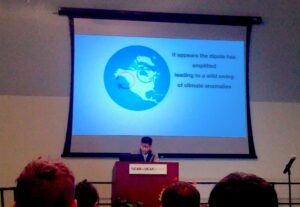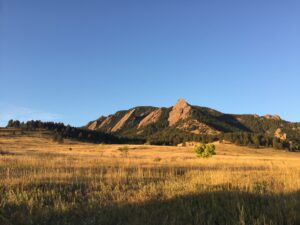“One thing you need to know about seasonal forecasts”
Contributed by Rachel Bazile, Marie-Amélie Boucher and Chris White.
“It is that they have no skill…”
This is how Matt Newman from NOAA’s ESRL referred to seasonal forecasts in his opening presentation at the Second International Conference on Subseasonal to Seasonal (S2S) / Seasonal to Decadal (S2D) Prediction. Organized by NCAR, the meeting which was held from Sept. 17 to 21 in Boulder, Colorado, had gathered more than 300 international scientists from both the S2S and S2D prediction communities… but it all started out rather pessimistically!
HEPEX was there!
As hydrologists, we also initially felt like outliers among all those meteorologists (what is this MJO thing anyways?). Still, as it quickly turned out, the conference was highly relevant for us.
Figure 1: HEPEXers present at the 2nd S2S conference! From left to right: Andrew Schepen, Chris White, Andy Woods, Rachel Bazile and Marie-Amélie Boucher.
It addressed the topics of predictability, quality assessment and initialization, as well as timescale interactions and decision-making based on forecasts, including, of course, hydrological forecasts.
Subseasonal to seasonal forecasting in hydrology: a bit of background
Figure 2: S-Y Simon Wang from Utah State University had the strange yet really cool idea to present the main ideas of his talk as a song with animated graphics. It was a first for many of us.
Let’s add a bit of hydrological context here. The Extended Streamflow Prediction (ESP) framework proposed by Day in 1985 is still the system to beat for long-term streamflow forecasting (e.g. García-Morales and Dubus, 2007; Singh, 2016). Within this framework, past meteorological observations are considered as equiprobable potential future scenarios, which are fed to a hydrological model. ESP is coherent with humans’ inclination to judge actual situations according to our memory of past experiences.
However, in the context of climate change, using dynamical meteorological forecasts instead of past climatology would seems like a good idea. Unfortunately, many recent studies regarding the use of dynamic climate models for long-term streamflow forecasting are rather depressing. For instance, in Weisheimer and Palmer (2014) the reliability of seasonal forecasts varied from “perfect” to “dangerous”.
Four important take home messages from the S2S/S2D conference
We identified four key messages that are relevant to the hydrological community.
- Seamless forecasting
Multi-model forecasting is more easily said than done in a S2S framework. Different meteorological institutions produce their forecasts on different initialisation dates and for different time horizons. One active area of research is to develop methods to unify these models ‘seamlessly’ across timescales from days to seasons. For hydrologists, seamless meteorological forecasts would simplify long-term streamflow forecasting and allow for multi-model ensembles much more easily.
- Predictability
”Larger scale phenomena take longer to be affected by initial condition errors that amplify via instabilities”*. It was rather encouraging to see that meteorological models can be quite successful at forecasting large-scale phenomena, such as El Niño or the Madden-Julian Oscillation (MJO) for instance. A question that remains is How can we take advantage of the predictability of large-scale phenomena to produce long-term forecasts of precipitation and temperature that are skillfull at a much smaller spatial scale? Or, if you prefer, how to « downscale predictability » for hydrological purposes?
- The need to improve the interaction between forecasters and end-users
Sounds familiar? Limitations to the operational use of meteorological forecasts at sub-seasonal and seasonal scale are numerous and there is a still a long way to be able to beat ESP. Further involvement of end-users from the sectors of agriculture, hydropower, maritime planning, etc. is needed and the forecasting community must reach out for them.
Figure 3: Boulder’s iconic Flatirons (photo by Joseph Monier)
- Data
Because of the extended forecasting horizon, the use of seasonal forecasts requires more care regarding how the data is organized. While the NetCDF standard has been widely accepted in the atmospheric sciences community, it is not readily the case in hydrology. Furthermore, several operational agencies have their own in-house built model that requires data in a specific format. Moreover, as mentioned by Roberto Buizza, if there were more tests done with real-time forecasts, data-related problems would be addressed more quickly, as they would be detected sooner.
So, No skill?
So was Matt Newman correct when he said that “It is that they have no skill…”? For sure he was being jokingly provocative in his opening line, but the demonstration of progress in both S2S and S2D forecasting, together with the size of the two S2S/S2D communities which had come together for the first time, showed there is significant progress being made on all fronts.
Figure 4: Post-conference hike in Rocky Mountain National Park (photo by Joseph Monier)
We observed that it would be the perfect time for the HEPEX community to merge more with the S2S/S2D communities, and perhaps we should also encourage our colleagues and partners from operational agencies to also get involved. In that regard, we think we can say it was a very successful meeting!
More hepexers next time!!
*This sentence was taken directly from one of the daily summaries of the conference (Presentation of Matt Newman)
References
Day, G. N. (1985). Extended streamflow forecasting using NWSRFS. Journal of Water Resources Planning and Management, 111(2), 157-170.
García‐Morales, M. B., & Dubus, L. (2007). Forecasting precipitation for hydroelectric power management: how to exploit GCM’s seasonal ensemble forecasts. International Journal of Climatology, 27(12), 1691-1705.
Singh, S. K. (2016). Long-term streamflow forecasting based on ensemble streamflow prediction technique: a case study in New Zealand. Water resources management, 30(7), 2295-2309.
Weisheimer, A., & Palmer, T. N. (2014). On the reliability of seasonal climate forecasts. Journal of the Royal Society Interface, 11(96), 20131162.




December 28, 2018 at 19:18
That’s not quite what I said. I said *on average* weeks 3-6 forecasts have no skill. My point is that these forecasts can only be useful if we can a priori identify the times when there is skill.
January 4, 2019 at 01:16
Thanks for the precision! The main idea we wanted to convey is that there is still a large room for improvement in seasonal ensemble forecasting. This was part of the conclusion of many presenters during the workshop. This makes long-term forecasting challenging and interesting.